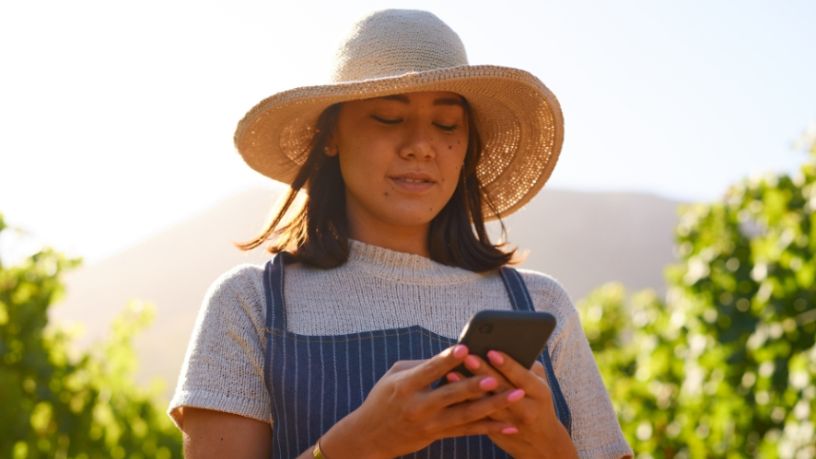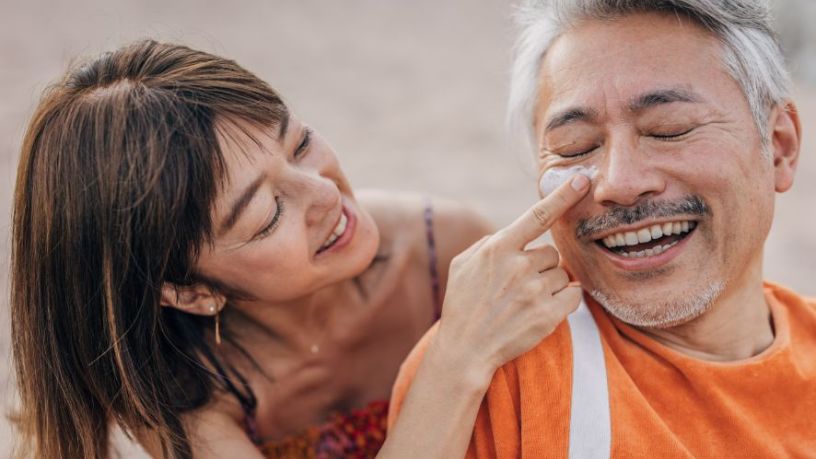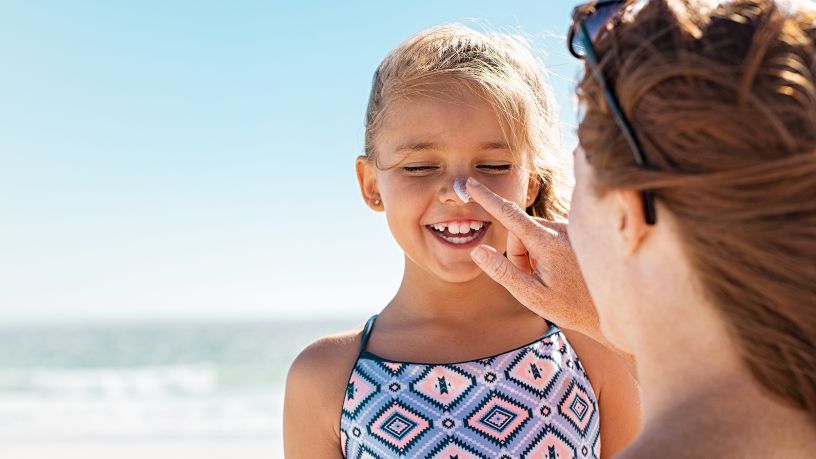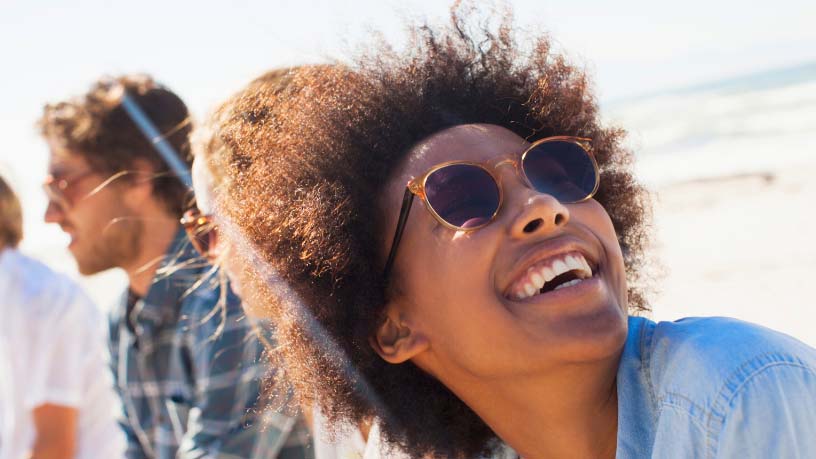Sunburn is the result of overexposure to ultraviolet (UV) radiation.
Key takeaways
While its immediate damage goes away, sunburn can lead to serious long-term risks including skin cancer.
It's important to practise sun safety when the UV index is 3 or above. Find out how you can stay safe in the sun year-round.
We've all had that unfortunate day at the beach where a mindless nap in the sun has left us as red as a tomato. But how dangerous is that sunburn?
To find out what damage the sun may be doing to you, we spoke to Professor Anne Cust, Chair of Cancer Council's National Skin Cancer Committee.
What is sunburn?
You may know how a sunburn looks and feels, but have you ever wondered what's actually happening to your skin?
"When you get a sunburn your skin cells are being damaged by ultraviolet (UV) radiation, and that can directly damage your DNA in your skin," says Professor Cust.
As your body reacts to overexposure to UV, it increases blood flow to the affected skin. This leads to inflammation, often causing redness, which may appear within a few hours, and peeling over the following days.
More extreme overexposure can cause blistering as a result of second or third degree burns.1
"It's an indication that your skin cells are in distress," says Professor Cust, adding that this is actually your body's way of managing and repairing the damage, with peeled skin making way for new skin.
However, while a sunburn will disappear, its long-term risks don't go away.
"There's lots of studies showing that getting a sunburn increases your risk of melanoma and other types of skin cancer," says Professor Cust.
The more times you get burned, the higher your risk of skin cancer. And the more severe the sunburn, the worse it is.
In fact, up to 95% of melanoma cases in Australia are caused by exposure to UV radiation. Adding to that, one out of 8 adults and one in every 5 teenagers will get sunburned on an average summer weekend.2
For Professor Cust, this is especially worrying given that 2 out of 3 Australians will develop skin cancer in their lifetimes.3
Overexposure to UV can also cause your skin to prematurely wrinkle over time.1
Understanding UV
While Australia enjoys a healthy dose of sunshine, the country also has among the highest consistent levels of UV radiation in the world.
Alongside infrared radiation (which creates heat) and visible light, the sun emits invisible UV radiation. While UV rays help give us vitamin D, in high amounts, exposure to it can be dangerous. And the harsh rays can even cause damage on cloudy days.
The danger of UV radiation is measured on a one-to-11+ UV index. This includes:
- 1 to 2: Low
- 3 to 5: Moderate
- 6 to 7: High
- 8 to 10: Very high
- 11 and above: Extreme.4
According to Professor Cust, certain factors can put you at a higher risk of skin cancer, including having fair skin, red hair and lots of moles or freckles.
"We've got a predominantly fair-skinned population," she says, "and the UV levels that we experience here are much higher than elsewhere in the world."
If fact, Australia's UV index regularly peaks at around 12 to 14 in summer and can even get as high as 17 in more northern parts of the country.5
How to stay safe in the sun
According to Professor Cust, intentional suntanning is never safe.
"That doesn't mean you shouldn't go outside and spend time at the beach," she adds.
But if you're at the beach or out doing leisure activities in the sun, use as many forms of sun protection as possible.
On any day in the year when the UV index is 3 or above, Cancer Council recommends implementing the 5 sun-safety S's. These are:
- Slip on sun-protecting clothing.
- Slop on broad-spectrum, water-resistant SPF50 or SPF50+ sunscreen.
- Slap on a broad-brimmed hat.
- Seek shade from the sun.
- Slide on a pair of sunglasses that meet Australian standards.6
To stay sun smart, Professor Cust also recommends that you and your loved ones keep these 6 tips in mind:
1. Check the UV index
You can do this with mobile apps or by checking online.
2. Apply sunscreen on days when the UV is forecast to be 3 or above
Checking the forecast in the morning can help you plan your day and start applying sunscreen before you leave the house.
3. Create other daily habits that allow you to be sun smart
This could include keeping a spare hat in the car or storing a tube of sunscreen in your bag.
4. Encourage your friends and loved ones to be sun smart too
In order for attitudes around sun safety to change in Australia, things like suntanning need to be reconsidered. If your loved ones want to lay on the beach this summer, encourage them to do so under shade!
5. Don’t assume that you’re either too old or too young to be at risk
As well as more casual attitudes among younger Australians, Professor Cust says she's noticed a relaxed attitude to sun safety among older people believing the damage is already done. But using sun protection at all ages can reduce your risk of developing skin cancer.
6. If you notice any spots on your skin that are new or changing, get them checked out right away
Your GP, dermatologist or specialist skin clinician can help you check for potentially cancerous spots on your skin. Getting regular checks may be important for you.
Resources
You can download Cancer Council's SunSmart Global UV app to access real-time and forecasted UV levels across Australia and the world.

At Bupa, trust is everything
Our health and wellbeing information is regularly reviewed and maintained by a team of healthcare experts, to ensure its relevancy and accuracy. Everyone's health journey is unique and health outcomes vary from person to person.
This content is not a replacement for personalised and specific medical, healthcare, or other professional advice. If you have concerns about your health, see your doctor or other health professional.
1Better Health Channel. (2024). Sunburn. Victoria State Government, Department of Health.
2Cancer Council. (2024). Causes of skin cancer. Cancer Council.
3Cancer Council. (2023). Skin cancer incidence and mortality. Cancer Council.
4Cancer Council. (2024). UV Index. Cancer Council.
5Cancer Council. (2020). UV radiation. Cancer Council.
6Cancer Council. (2024). Preventing skin cancer. Cancer Council.
You might also like...
Can you get a sunburn through clothes?
Most people understand the need to wear sunblock or SPF protective moisturiser. But did you know you can also get burnt through your clothes?
How to choose the perfect sunscreen
A good sunscreen is one of the most important pieces of a flawless Aussie beauty routine, but which kind works best for your skin?
A pro guide to applying sunscreen
You probably know that sunscreen can protect you from the dangers of the sun, but are you applying it correctly?
Suntanning culture
Australia has the highest skin cancer rate in the world, but that doesn’t stop us from suntanning. Learn about the dangers of laying out in the sun.





